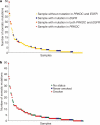Somatic mutations affect key pathways in lung adenocarcinoma
- PMID: 18948947
- PMCID: PMC2694412
- DOI: 10.1038/nature07423
Somatic mutations affect key pathways in lung adenocarcinoma
Abstract
Determining the genetic basis of cancer requires comprehensive analyses of large collections of histopathologically well-classified primary tumours. Here we report the results of a collaborative study to discover somatic mutations in 188 human lung adenocarcinomas. DNA sequencing of 623 genes with known or potential relationships to cancer revealed more than 1,000 somatic mutations across the samples. Our analysis identified 26 genes that are mutated at significantly high frequencies and thus are probably involved in carcinogenesis. The frequently mutated genes include tyrosine kinases, among them the EGFR homologue ERBB4; multiple ephrin receptor genes, notably EPHA3; vascular endothelial growth factor receptor KDR; and NTRK genes. These data provide evidence of somatic mutations in primary lung adenocarcinoma for several tumour suppressor genes involved in other cancers--including NF1, APC, RB1 and ATM--and for sequence changes in PTPRD as well as the frequently deleted gene LRP1B. The observed mutational profiles correlate with clinical features, smoking status and DNA repair defects. These results are reinforced by data integration including single nucleotide polymorphism array and gene expression array. Our findings shed further light on several important signalling pathways involved in lung adenocarcinoma, and suggest new molecular targets for treatment.
Figures






References
-
- Juergens RA, Brahmer JR. Adjuvant treatment in non-small cell lung cancer: Where are we now? J. Natl Compr. Canc. Netw. 2006;4:595–600. - PubMed
-
- Parkin DM, Bray F, Ferlay J, Pisani P. Global cancer statistics, 2002. CA Cancer J. Clin. 2005;55:74–108. - PubMed
-
- Hecht SS. Tobacco smoke carcinogens and lung cancer. J. Natl Cancer Inst. 1999;91:1194–1210. - PubMed
-
- Hung RJ, et al. A susceptibility locus for lung cancer maps to nicotinic acetylcholine receptor subunit genes on 15q25. Nature. 2008;452:633–637. - PubMed
-
- Sellers TA, et al. Evidence for mendelian inheritance in the pathogenesis of lung cancer. J. Natl Cancer Inst. 1990;82:1272–1279. - PubMed
Publication types
MeSH terms
Grants and funding
LinkOut - more resources
Full Text Sources
Other Literature Sources
Medical
Molecular Biology Databases
Research Materials
Miscellaneous

